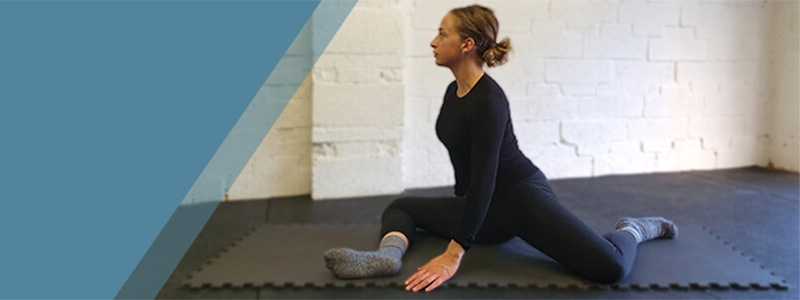
Post Workout: Full Body Stretch
What should you do post workout? Our personal trainer, Jess, outlines an effective cool down and full body stretch routine.
To cool down post workout, you should slowly reduce your exercise intensity over 3-5 minutes. First, bring down your RPE (rate of perceived exertion) from a 7-9 (intense exertion) to a 3-4. Then, reduce to 1-2 and finally, stop moving.
Pair your cool down with a calming full body stretch routine. This will help you to fully harness the mental health benefits of your workout. Read on to discover my most tried and tested stretches for full mind and body balance.
Full Body Stretch Routine
The following 10 stretches cover all the main muscle groups in the upper and lower body. I recommend that you do these after every workout and at least 2-3 times per week. So, even if you aren’t working out that much, try to find time to stretch.
1) Piriformis Figure Four Stretch
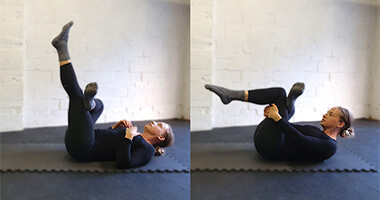
This stretches your glutes and hamstrings.
How to do the piriformis figure four stretch:
- Lying on your back, raise your legs in the air. Bend your right knee and place the right ankle just above the left knee.
- Bend the left knee, and reach through the gap in your legs to clasp around the left thigh.
- Keep both hips straight and pushed into the ground.
- Gently increase the stretch by pulling the left thigh towards the chest.
- Hold for one minute on each side.
2) 90/90 Stretch
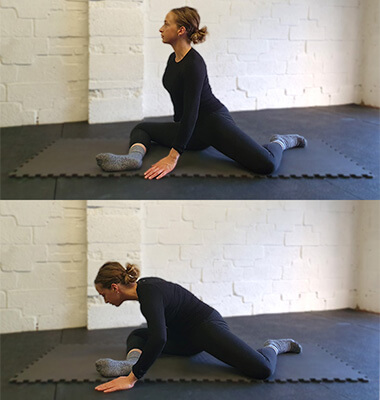
This stretches your hips and glutes.
How to do the 90/90 stretch:
- Sit on the ground with your feet out in front of you.
- Switch your legs so the right leg is out in front of you. Position your right shin bone horizontally in front of you, knee bent at a 90 degree angle.
- Your left leg should be out behind you, bend the knee at a 90 degree angle.
- Stretch your torso up high and hinge at the hips leaning forward over the right leg, hands supporting you.
- Hold for one minute each side.
3) Deep Squat
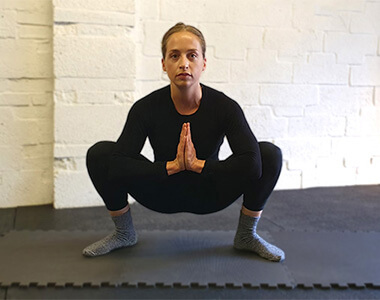
This stretches your ankles, thighs and hips.
How to do the deep squat:
- With your feet hip width apart and facing outwards, lower down into a deep squat.
- With your hands in a prayer position, bring the arms inside the knees.
- Use the elbows to slowly push out the knees.
- Take a deep breath.
- If this stretch is too intense use a rolled-up blanket, foam roller or stack of books to sit back onto, gradually lowering over time. Make sure not to put pressure on sore knees or lower back.
4) Downward Facing Dog
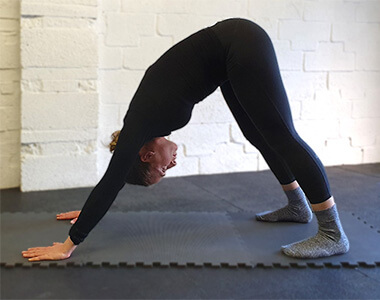
This stretches your hips, hamstrings and calves.
How to do a downward facing dog:
- Stand with your feet hip width apart.
- Hinge at the hips, bend the knees slightly and walk your hand out in front of you.
- You want to get into a position where your arms are straight, shoulders spread back and down, elbows twisted out.
- Suck in your stomach, engaging the core and push through your hands, lengthening the back.
- Try to get your feet flat on the floor. But, if not, keep the knees soft and bent and stay up on the toes.
- Hold for 1 minute.
5) Cobra Pose
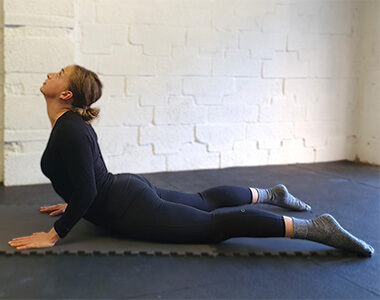
This stretches your lower back, core, hip flexors and neck.
How to do the cobra pose:
- Lying on your stomach, post up onto your elbows.
- Squeeze the glutes and push your hips into the ground, as you arch your lower back and look up to the ceiling.
- Keep the shoulders squeezed back.
- Hold for 30-45 seconds.
6) Chest Stretch

This stretches your chest and hip flexor.
How to do the chest stretch:
- Lying on your front, put your arms out horizontally and bend the elbows at a 90 degree angle.
- Place the left palm flat onto the floor, keeping the right arm in the horizontal ‘hands up’ position.
- Post up pushing upwards lifting the shoulder off the floor along with the left hip.
- Bend the left knee.
- Push the right armpit into the ground.
- Increase the stretch gently.
- Hold for 30-45 seconds each side.
7) Shoulder Y Stretch

This stretches your rear deltoids.
How to do the shoulder Y stretch:
- Lying flat on your front, arms up above you in a Y.
- Peel the right arm off the floor, whilst simultaneously pushing the left shoulder into the floor.
- Let the hips move with the twist, bringing the right knee up to 90 degrees.
- Hold for about 10 seconds and roll back over and repeat on the other side.
- Keep rolling backwards and forwards for 1 minute.
8) Cat

This stretches your upper back, traps and rear delts.
How to do the cat pose:
- On your hands and knees, wrists and shoulders stacked underneath each other.
- Lead with the pelvis, tucking it in, sucking in the pelvic floor and squeezing the glutes.
- Arch the rest of the back as high as you can, dropping the head down.
- For 1 minute alternate between the cat and cow pose (below).
9) Cow

This stretches your upper back, traps and rear delts.
How to do the cow post:
- Moving on from the cat pose, lead with the pelvis – tip it forward.
- Hyperextend the lower back and push the belly towards the ground.
- Squeeze the shoulders back and look towards the ceiling.
10) Low Lunge with Twist

This stretches your neck, shoulders, hips and hamstrings.
How to do a low lunge with twist:
- Step out into a lunge position, right foot in front of you.
- Your right knee should be directly over your right ankle, not further forward.
- Your left leg should be behind you, toes facing out at a right angle.
- Keep your legs in a straight line. Take your right hand and place it flat on the ground to the left of your foot, palm and heel side by side touching.
- Extend the left arm straight up above you, arm straight. Look up towards your fingertips.
- You should feel the stretch in your neck, shoulders, hips and hamstrings.
- Hold for 30-45 seconds each side.
Benefits Full Body Stretching
Performing a full body stretch routine can help to realign your body. It also prevents the likelihood of injury, for the following reasons:
- Corrects imbalance: Stretching can address any postural imbalances caused by your specific workout. For example, if you cycle, your hip flexors may become tight.
- Breaks down lactic acid: Stretching breaks down the lactic acid that can build up in your muscles during exercise. This prevents muscle soreness.
- Repairs muscle fibres: Stretching helps blood to circulate in the muscles which aids muscle fibre repair.
The lives we lead don’t tend to be conducive to the ways our bodies are designed. Long periods of sitting at work or commuting also need to be counteracted. We can do this by dedicating time to a full body stretch as often as possible.
Full Body Stretch Accessories
Foam rollers are great for helping relieve tension and soreness by providing a targeted massage to your muscles.
Textured foam rollers are recommended by physios to rehabilitate, release and massage tight muscles as well as improve circulation.





